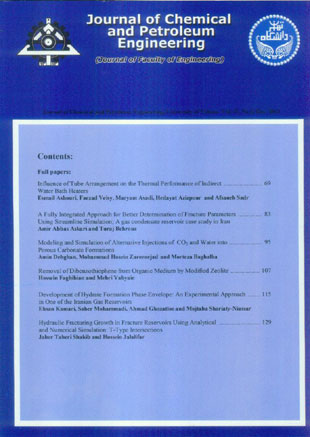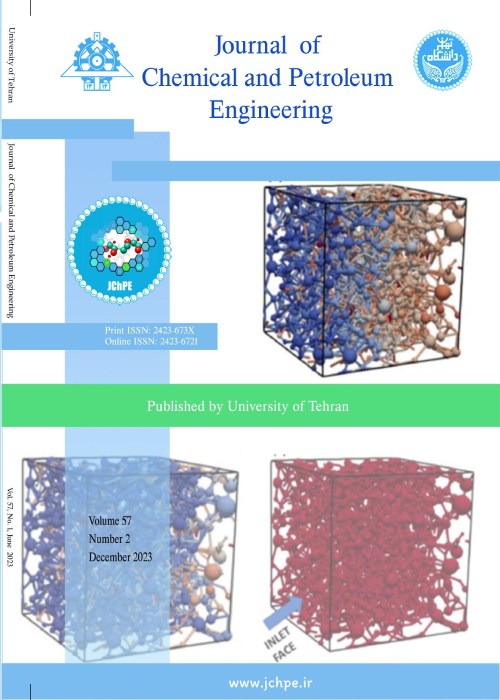فهرست مطالب

Journal of Chemical and Petroleum Engineering
Volume:47 Issue: 2, Dec 2013
- تاریخ انتشار: 1392/09/10
- تعداد عناوین: 6
-
-
Pages 69-81Natural convection heat transfer from a tube bundle in the indirect water bath heaters is investigated. A computer-code is used for the solution of the governing equations of mass, momentum and energy transfer based on the SIMPLE-C algorithm. Simulations are carried out for the gas pressure station heater of Kermanshah city with various tube bundle arrangements. In order to validate the numerical code, results of the simulation compared with experimental data which measured from this heater. Effects of the tube bundle arrangement on heat transfer are presented. It is observed that changing the tube bundle arrangement (horizontal and vertical pitch) can affect the rate of heat transfer. In other word it can lead to increase the thermal performance of the indirect water bath heater. Finally, based on this framework it is suggested that the optimum arrangement of tube bundle can lead to the maximum heat transfer. Hence the performance enhances to 5.27%.Keywords: Tube arrangement, Natural convection, Indirect water bath heater, City gas station, Heater performance
-
Pages 83-94Many large oil and gas fields in the most productive world regions happen to be fractured. The exploration and development of these reservoirs is a true challenge for many operators. These difficulties are due to uncertainties in geological fracture properties such as aperture, length, connectivity and intensity distribution. To successfully address these challenges, it is paramount to improve the approach of characterization and simulation of fractured reservoirs. In this study, a fully integration of all available data and methods have been used for generating stochastic discrete fracture network (DFN)such as outcrop study, core description, petrophysical and image logs and also for better result validation, streamline simulation has been conducted. In this comprehensive process a real gas condensate fractured carbonate reservoir has been used. Firstly, three main fracture sets were defined that have fold-related fractures, then the fracture intensity and DFN model using fracture drivers correlation were generated. After that, permeability of the developed DFNs was calibrated with available well test permeability. Then, a streamline simulation was used because of its high computational speed, high accuracy and good visualization for the repeated nature of history matching of a dual porosity model in the gas condensate reservoir. So, with running streamline simulation, three realizations (High, Medium and Low) ranked based on the objective function values. These three realizations are common realization that are well known with optimistic, most likely and pessimistic scenarios. Finally, comprehensive history matching was done for all the three-selected realizations. The overall goal is to develop a representative fluid flow simulation model for improving gas cycling procedure in gas condensate reservoir. This method has great application in the high resolution fractured reservoir modeling due to using actual fracture parameters. Also, it can be used for model ranking, screening and optimum dynamic model calibration for reduction of the history matching complexity without being manipulated by reservoir engineer.Keywords: Fracture parameters, DFN model, Fast history matching, Streamline simulation, DST matching
-
Pages 95-105Water alternating gas (WAG) technique is used in the petroleum industry to inject carbon dioxide (CO2) into underground formations either for sequestration or enhanced oil recovery (EOR) processes. CO2 injection causes reactions with formation brine or aquifer and produces carbonic acid, the acid dissolves calcite and changes flow behavior significantly. Modeling and investigating effects of CO2 injection into carbonate formations during WAG processes, investigating parameters related to chemical reactions between reservoir rock and injecting fluid and also better understanding of the process theory for future experiments are the most important goals of this paper. To achieve these experimental data were used. Changes of output calcium concentration from a calcite core sample during three WAG cycles have been studied in laboratory works. The sample is modeled as a medium consisting of a set of capillary pipes and two pore size distribution models are used. Plug flow model and mass conservation law are used for modeling and Darcy law and Hagen-Poiseuille equation are also used to determine characteristics of the porous model. The model is built for linear, miscible and one-dimensional flow. The results show that experimental and model data coincide well in the first and second cycles of both porous models however; they are not coincided in the third cycle. It is because of precipitation and dissolution that cause permeability alternations. Results of the two porous models are compared also.Keywords: Water alternating gas, Carbon dioxide, Pore size distribution, Porous medium model, Reaction rate constant
-
Pages 107-114In this research, adsorption of dibenzothiophene (DBT) as a model of sulfur containing material has been studied by Pb exchanged Y-zeolite under different experimental conditions. The adsorption was kinetically fast and high adsorption capacity was obtained. The equilibrium adsorption data were analyzed using Langmuir and Freunlich isotherm models. The corresponding parameters and correlation coefficients of each model are reported and the data was well fitted by the Langmuir isotherm. Pseudo-first order, pseudo-second order and intra-particle diffusion models were evaluated to examine the kinetic of the adsorption process. It was concluded that removal of DBT was obeys the second-order model of kinetic. The adsorbent was tested for five successive regeneration cycles and the considerable capacity of the adsorbent was remained after regeneration.Keywords: Pb, Y zeolite, Adsorption, Dibenzothiophene, Equilibrium, Kinetic
-
Pages 115-127Iran''s proved natural gas reserves are the world''s second largest reserves. Mainly, because of different climate changes and different reservoirs characterizations, studying the behavior of producing outcome fluids and their transportation, is of major interest. One of the main problems occur in the gas reservoirs is related to the hydrate formation while producing from a well, either in production strings or lines (before and after choke). Effective parameters which lead to hydrate formations are: high pressure in strings, low wellhead temperature together with water presence; and hence, the high possibility of having this phenomenon in the reservoirs is quite obvious for the gas wells. Hydrate formation in production lines and facilities will also lead to different impediments such as: complete or partial closure in production lines and heat exchangers, erosion of the equipment, pressure reduction, and etc. In this research, the conditions of hydrate formation, using the experimental data from one the Iranian sour gas field that is helpful to determine the safe/unsafe zones by P-T curves, are thoroughly investigated. In addition, the results will be compared to the other presented correlations available in the literature.Keywords: Experimental, Gas condensate reservoir, Hydrate, Phase equilibrium, Production
-
Pages 129-138Hydraulic fracture diagnostics have highlighted the potentially complex natural of hydraulic fracture geometry and propagation. This has been particularly true in the cases of hydraulic fracture growth in naturally fractured reservoirs، where the induced fractures interact with pre-existing natural fractures. A simplified analytical and numerical model has been developed to account for mechanical interaction between induced and natural fractures. Analysis of the distance between natural fractures indicates that induced shear and tensile may be high enough to debond sealed natural fractures ahead of the arrival of the hydraulic fracture tip. We present a complex hydraulic fracture pattern propagation model based on the Extended Finite Element Method (XFEM) as a design tool that can be used to optimize treatment parameters under complex propagation conditions. Results demonstrate that fracture pattern complexity is strongly controlled by the magnitude of anisotropy of in situ stresses، and natural fracture cement strength as well as the orientation of the natural fractures relative to the hydraulic fracture.Keywords: Distance, Induced fracture, Intersection, Shear, Tensile


